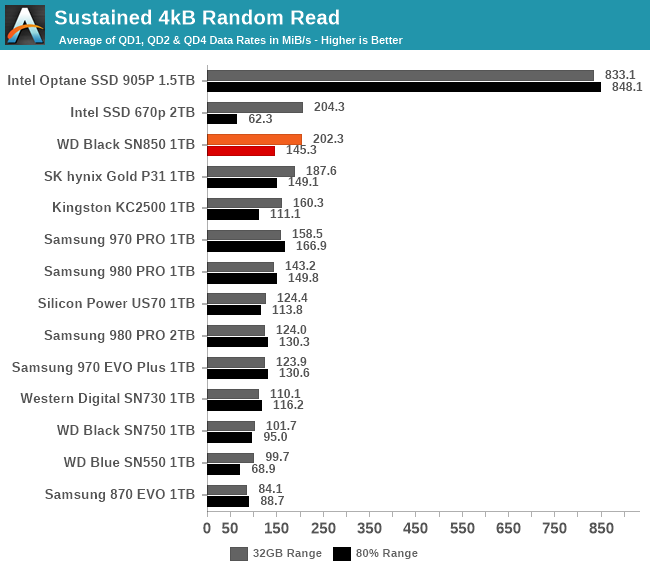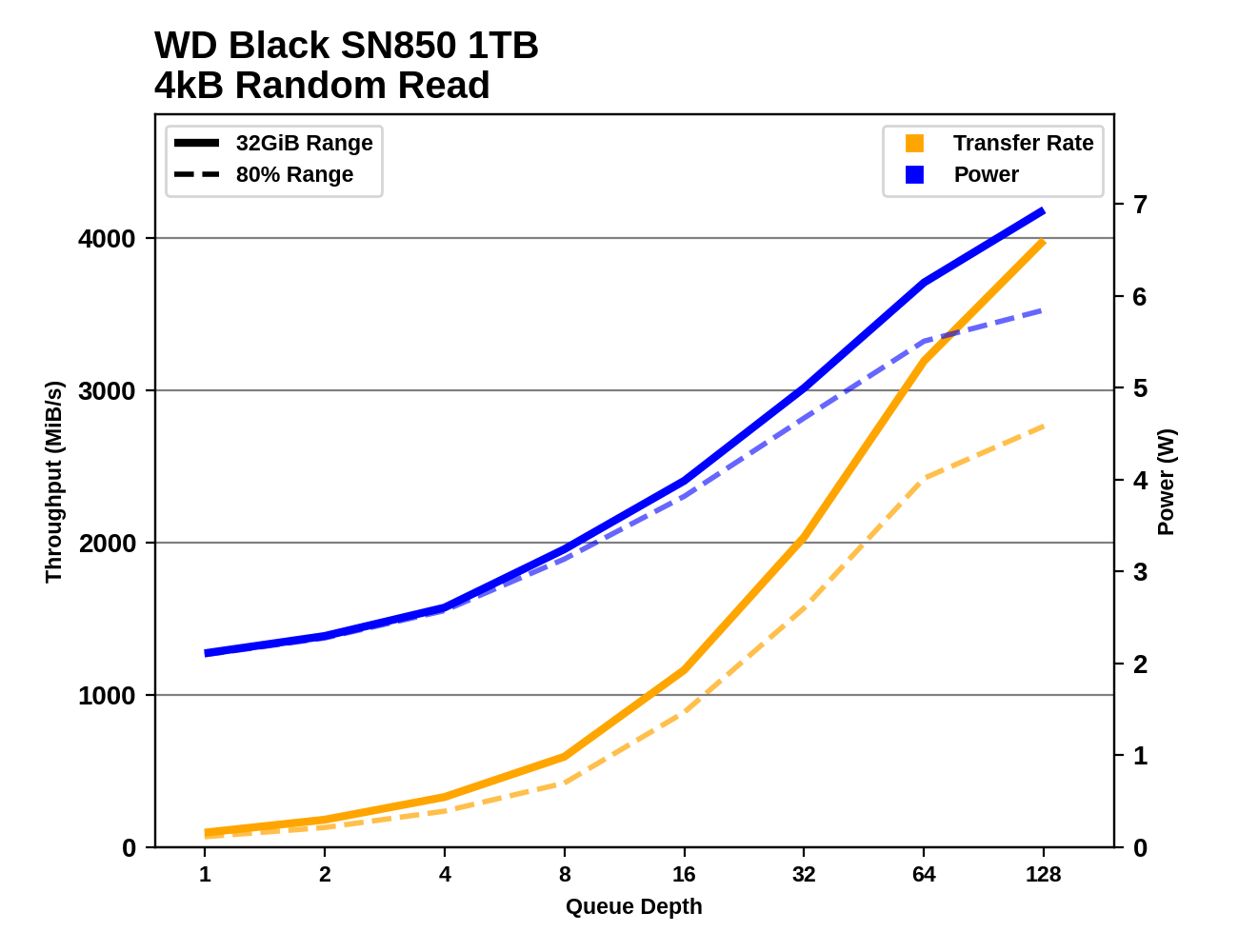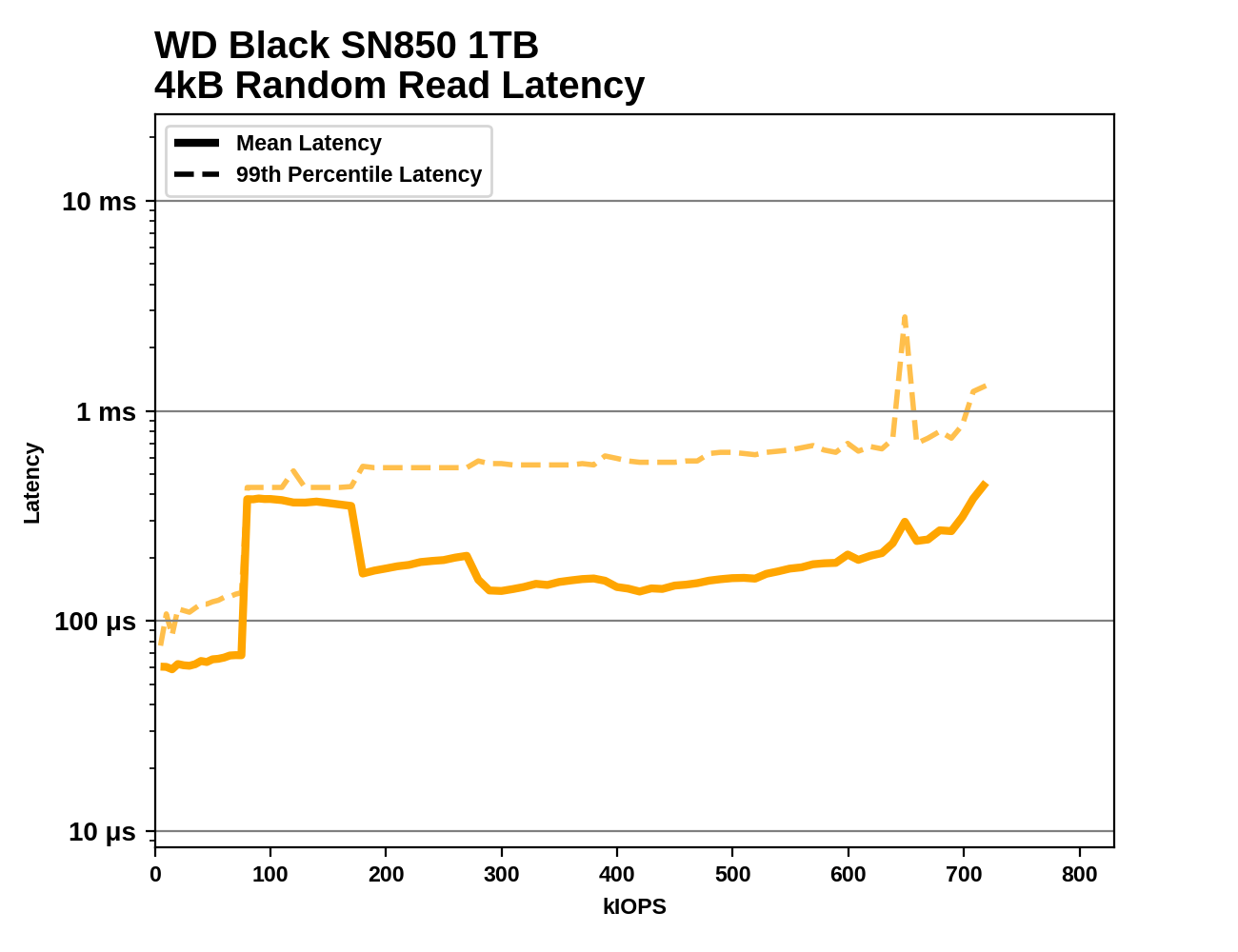The Western Digital WD Black SN850 Review: A Very Fast PCIe 4.0 SSD
by Billy Tallis on March 18, 2021 12:50 PM ESTBurst IO Performance
Our burst IO tests operate at queue depth 1 and perform several short data transfers interspersed with idle time. The random read and write tests consist of 32 bursts of up to 64MB each. The sequential read and write tests use eight bursts of up to 128MB each. For more details, please see the overview of our 2021 Consumer SSD Benchmark Suite.
 |
|||||||||
| Random Read | Random Write | ||||||||
| Sequential Read | Sequential Write | ||||||||
The WD Black SN850 turns in excellent scores on almost all of the burst IO tests. For random reads, it edges out the Intel SSD 670p to set a new record for flash-based SSDs, and even when testing beyond the bounds of any possible SLC caching it is only 2% slower than the MLC-based Samsung 970 PRO. For random writes the WD Black SN850 is slightly slower than the Phison E16 drive, but otherwise is s clear step up in performance from the rest of the field. When testing sequential transfers on a small slice of the drive, the SN850 is substantially faster than everything else, but when testing across 80% of the drive its sequential read performance drops dramatically and is beat by the Samsung 980 PRO and several of the faster PCIe 3.0 drives.
Sustained IO Performance
Our sustained IO tests exercise a range of queue depths and transfer more data than the burst IO tests, but still have limits to keep the duration somewhat realistic. The primary scores we report are focused on the low queue depths that make up the bulk of consumer storage workloads. For more details, please see the overview of our 2021 Consumer SSD Benchmark Suite.
 |
|||||||||
| Random Read | Throughput | Power | Efficiency | ||||||
| Random Write | Throughput | Power | Efficiency | ||||||
| Sequential Read | Throughput | Power | Efficiency | ||||||
| Sequential Write | Throughput | Power | Efficiency | ||||||
On the longer random read test, the WD Black SN850 doesn't quite stand out from the best performance offered by other drives with newer flash. But on the other three workloads the SN850 is clearly superior, with significant performance leads over the rest of the competition. Its power consumption is consistently on the high side and in some cases it is drawing more than any of the other drives, but the performance is high enough that the efficiency scores are all good.
 |
|||||||||
| Random Read | |||||||||
| Random Write | |||||||||
| Sequential Read | |||||||||
| Sequential Write | |||||||||
For random reads, the SN850 eventually ramps up to around 4GB/s or 1M IOPS at the end of the test, which is significantly faster than any other drive that we've tested so far on this new test suite. However, when testing across 80% of the drive instead of just a 32GB slice, the random read performance falls to roughly the same level as the Samsung 980 PRO.
For random writes, the SN850's performance scales up a bit quicker than the 980 PRO, but it hits a throughput limit sooner and the 980 PRO ends up being much faster for random writes to the SLC cache at high queue depth.
For sequential reads, the SN850 ends up slightly faster than the 980 PRO, but when testing across 80% of the drive the Samsung reaches full performance with a lower queue depth. For sequential writes the SN850 is again a bit faster than the 980 PRO and this time it doesn't need higher queue depths to reach full speed, but it also starts running out of SLC cache before the test is over while the 980 PRO maintains full performance through the end of the test.
Random Read Latency
This test illustrates how drives with higher throughput don't always offer better IO latency and Quality of Service (QoS), and that latency often gets much worse when a drive is pushed to its limits. This test is more intense than real-world consumer workloads and the results can be a bit noisy, but large differences that show up clearly on a log scale plot are meaningful. For more details, please see the overview of our 2021 Consumer SSD Benchmark Suite.
 |
|||||||||
The WD Black SN850 starts off this test with good random read latency, but around 80k IOPS it shifts gears and latency spikes alarmingly. It actually improves a few times later in the test so by the time the drive is approaching its throughput limit, it is only a bit slower than the Samsung 980 PRO.










83 Comments
View All Comments
Chaitanya - Thursday, March 18, 2021 - link
Very interesting drive.bernstein - Thursday, March 18, 2021 - link
great review! thanks @anandtechabufrejoval - Thursday, March 18, 2021 - link
Somehow I think that I'll never be able to recover in the faster response times of this drive the time it would take me to swap it against the 980 Pro I currently have in my Ryzen 5800X workstation...Against any other with similar price and capacity, it would win. In absolute terms, I doubt it really matters for most, because the bottleneck will be somewhere else.
abufrejoval - Thursday, March 18, 2021 - link
actually an MLC 970 pro... need editXabanakFanatik - Thursday, March 18, 2021 - link
I was going to say.... Seems like this is a better performing drive than the 980 Pro. 970 pro, it's a close call. The upside is this ca be had in 2TBbji - Friday, March 19, 2021 - link
If you swap it at a time when you otherwise would not be using the computer, then you effectively don't have to "recover" anything.Spunjji - Friday, March 19, 2021 - link
No, but that's an odd way to look at it. There's no need to replace a perfectly good drive!Linustechtips12#6900xt - Thursday, March 18, 2021 - link
I think that this is. a decent drive after skimming threw the article but i definitely do wonder how far the M.2 standard will be in use obviously a while im not saying its obsolete but when U.3 exists. I think that 2.5in drives will make a come back because in all honesty you cant fit everything on a 2tb drive and capacity that high is EXPENSIVE so i think 2.5in U.3 is gonna be where its at and im gonna wait for it to, i wanna get something better than a hdd for my game storage but when sata is going out i dont wanna buy a sata ssd.eva02langley - Thursday, March 18, 2021 - link
The playstation 5 use NVMe, so it is going to be around for a while. SATA is definitely dead.futrtrubl - Thursday, March 18, 2021 - link
Don't confuse NVMe and M.2.